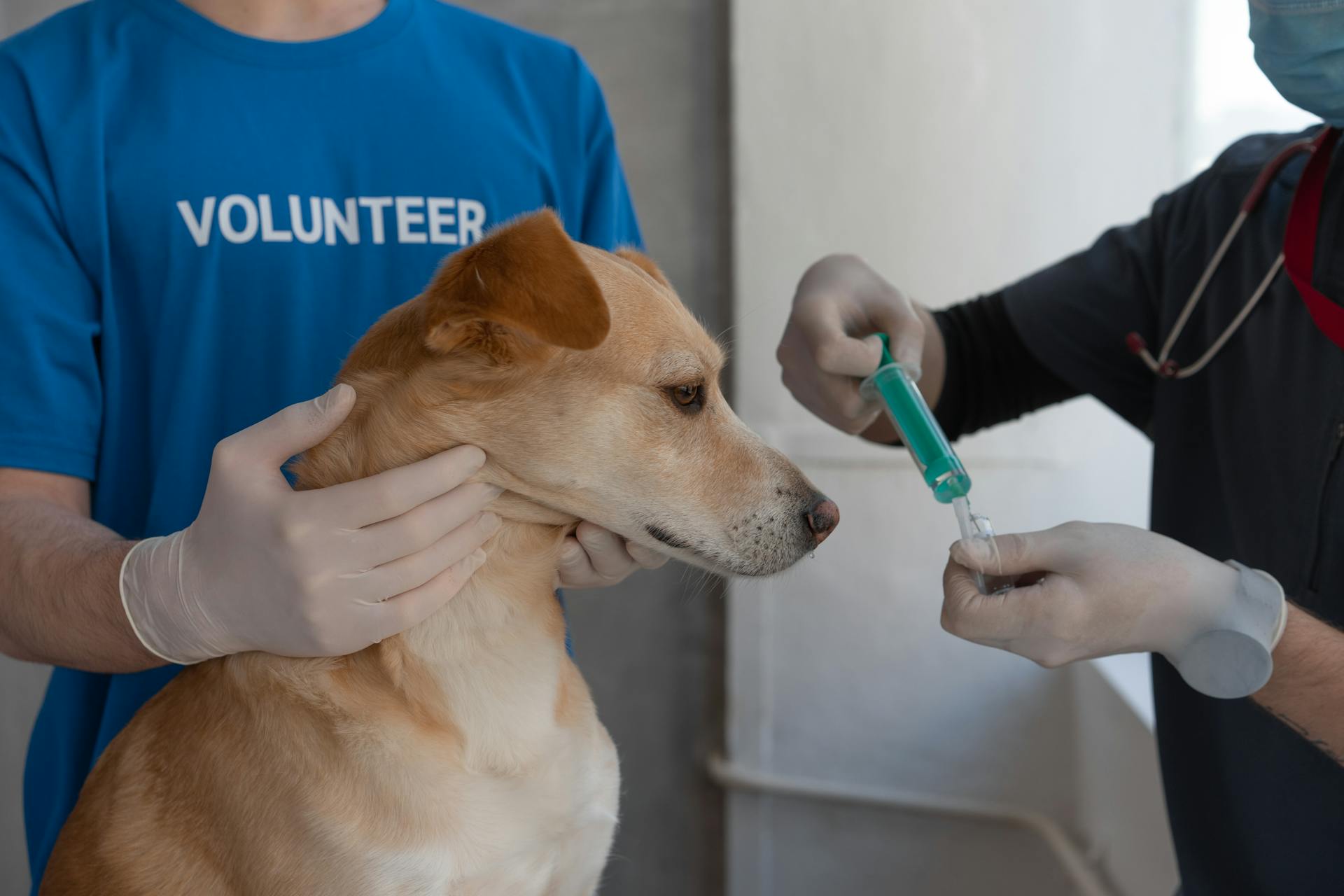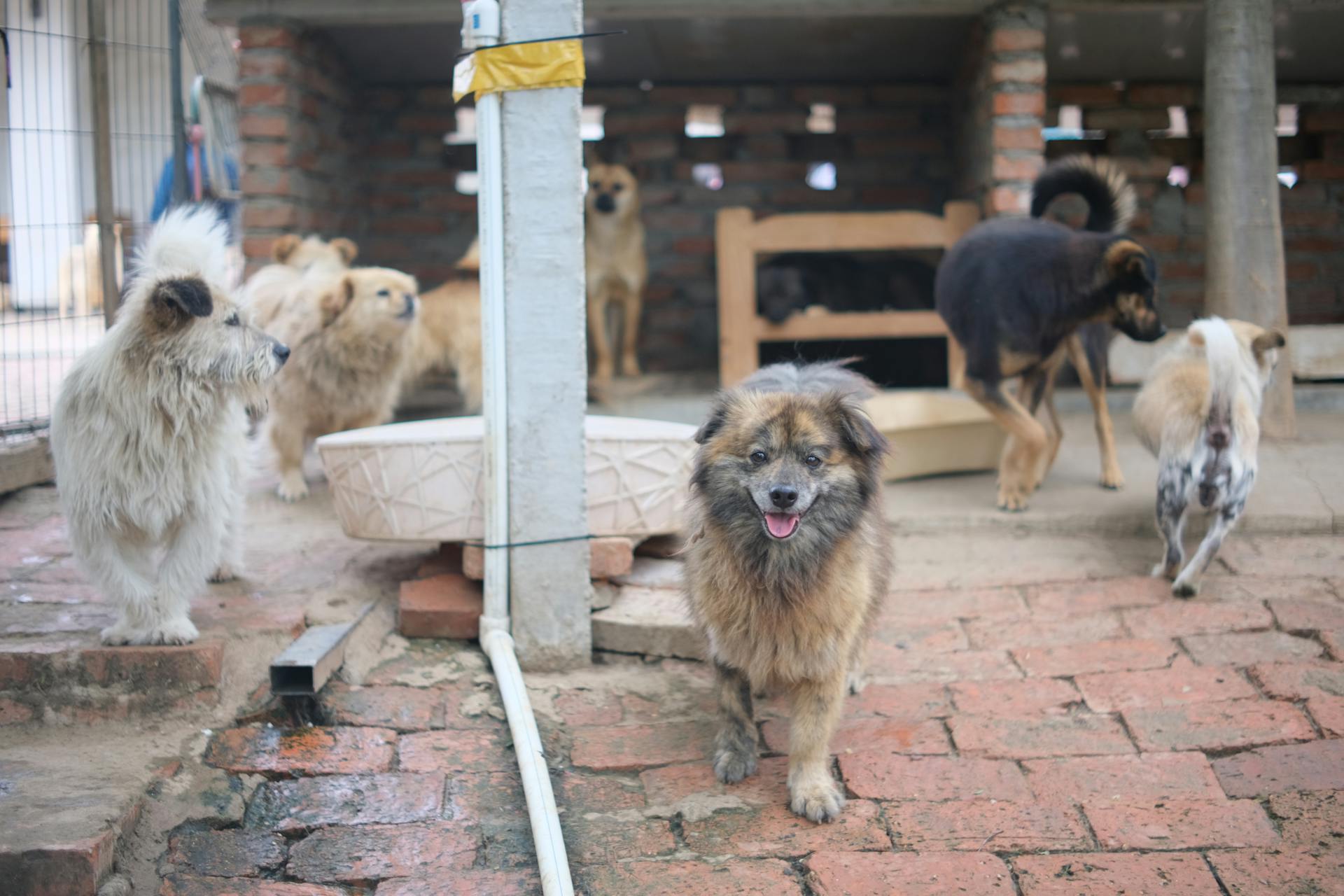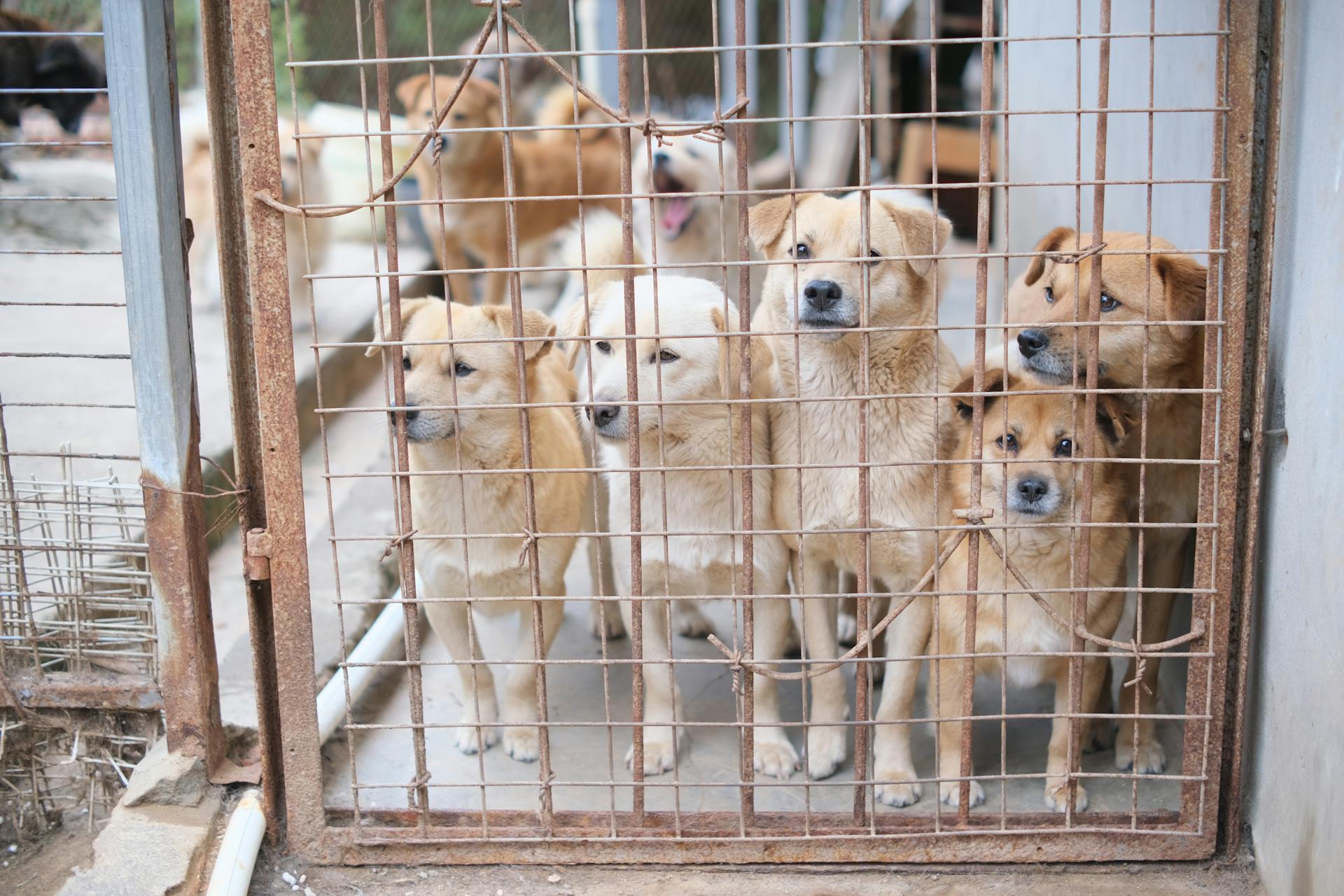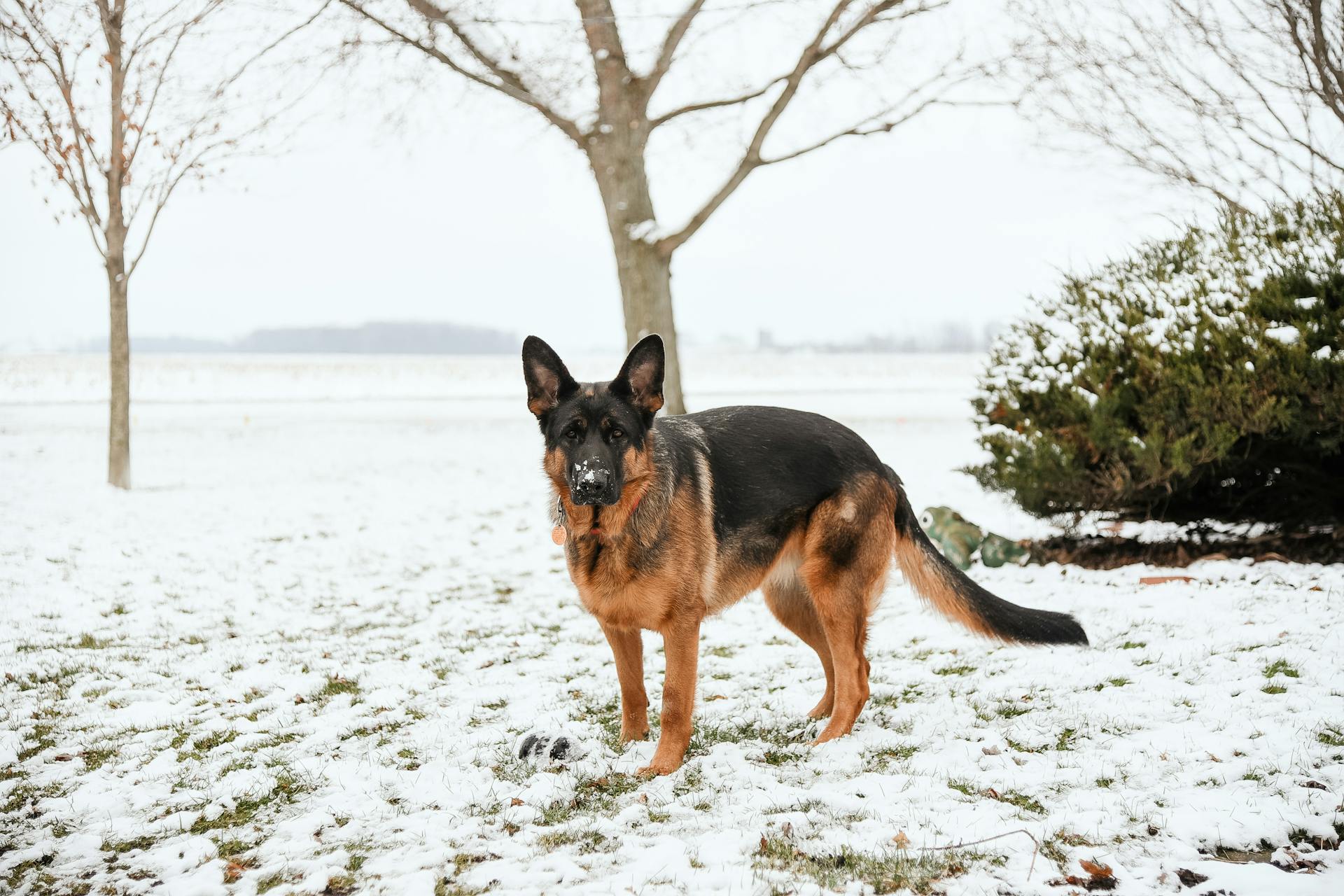
Canine parvovirus 2 is a highly contagious and potentially life-threatening disease that affects dogs worldwide.
The virus has a unique life cycle that involves several stages, starting with the attachment of the virus to the host cell's surface receptors.
The virus then enters the host cell through a process called receptor-mediated endocytosis, where it's engulfed by the cell membrane.
Once inside the host cell, the virus releases its genetic material and begins to replicate.
The virus replicates its genetic material through a process called transcription, where the viral DNA is transcribed into messenger RNA.
The newly synthesized viral particles are then assembled and released from the host cell through a process called lysis.
This cycle of infection and replication can lead to severe gastrointestinal symptoms and even death in dogs if left untreated.
See what others are reading: Dog Flea Stages
Virology of CPV-2
Canine parvovirus 2, or CPV-2, is a member of the Parvoviridae family, specifically the genus Protoparvovirus. Its genome is a single-stranded, negative-sense, linear DNA of about 5 kb.
Curious to learn more? Check out: Canine Distemper Adenovirus Type 2 Parainfluenza Parvovirus Vaccine
The CPV-2 genome contains two open reading frames, or ORFs, which are translated into 4 proteins through alternative splicing. One ORF is associated with the non-structural proteins NS1 and NS2, which are mainly related to viral replication.
The second ORF is related to the viral capsid constituents VP1 and VP2. After the cleavage of VP2, VP3 is formed due to the involvement of host proteases.
The capsid of CPV-2 has 60 protein subunits, 90% of which are VP2 (67 kDa) and 10% are VP1 (83 kDa).
Intriguing read: 2 German Shepherds
What Happens During Infection?
Once a dog is infected with CPV, there's an incubation period of three to seven days before symptoms start showing.
The virus begins by attacking the tonsils or lymph nodes of the throat, where it invades lymphocytes, a type of white blood cell, for one or two days, creating many copies of itself.
This invasion causes a reduction in the number of circulating lymphocytes, a condition called lymphopenia.
The virus then enters the bloodstream and targets rapidly dividing cells, hitting hardest in the bone marrow and in the cells that line the walls of the small intestine.
In very young dogs, CPV can also infect the heart, leading to inflammation of heart muscle, poor function, and arrhythmias.
The virus weakens the body's ability to protect itself by destroying young immune cells and causing a drop in the protective white blood cell count, making it easier for the virus to invade the gastrointestinal tract.
Severe diarrhea and nausea are the initial result of the virus's invasion of the intestinal surface, where it disables the body's ability to replenish the intestinal surface with fresh new cells.
Broaden your view: Canine Heart Cancer
Infection Process
The infection process of CPV in dogs is a complex and devastating one. It starts with an incubation period of three to seven days before symptoms appear.
CPV attacks the tonsils or lymph nodes of the throat first, where it invades lymphocytes and creates many copies of itself. These viruses then hitch a ride inside the lymphocytes, sheltered from the host defenses.
The virus targets rapidly dividing cells, hitting hardest in the bone marrow and in the cells that line the walls of the small intestine. This causes a drop in the protective white blood cell count, making it easier for the virus to invade the gastrointestinal tract.
In very young dogs, CPV can also infect the heart, leading to inflammation of heart muscle and poor function. This can result in arrhythmias and other serious complications.
The virus causes destruction in the bone marrow by destroying young immune cells, weakening the body's ability to protect itself. This makes it harder for the body to fight off the infection.
CPV invades the crypts of Lieberkühn in the small intestine, where new epithelial cells are born. It disables the body's ability to replenish the intestinal surface, leading to severe diarrhea and nausea.
Eventually, the intestinal surface can become so damaged that it begins to break down, allowing bacteria to penetrate the intestine walls and enter the bloodstream. This causes widespread infection inside the body.
Readers also liked: Canine Bone Cancer Life Expectancy
Host Response
As your body responds to an infection, it activates its immune system to fight off the invading pathogens.
White blood cells, such as neutrophils and macrophages, are sent to the affected area to engulf and digest the invading microbes.
Your immune system also produces cytokines, signaling molecules that coordinate the response and recruit more immune cells to the site of infection.
Fever, chills, and fatigue are common symptoms of a host response, as your body tries to contain the infection and recover.
Your body's temperature rises, making it less hospitable to the invading pathogens, while also speeding up your metabolism to help fight off the infection.
Virus Isolation
Virus isolation is considered the gold standard for diagnosing viral diseases, and it's a crucial step in understanding the life cycle of canine parvovirus 2 (CPV-2).
Special cell lines like CRFK, MDCK, and A-72 are used for the isolation and propagation of CPV-2, because they can detect the virus's presence.
The adapted virus causes distinct cytopathic effects in infected cell lines, including cell rounding, aggregation, and necrosis of the affected cells.
This process requires specialized laboratory equipment and is a laborious process, making it a significant undertaking.
CPV-2 Life Cycle

The CPV-2 genome is a single-stranded, negative-sense, linear DNA of about 5 kb.
The genome is contained by two ORFs, which are translated into 4 proteins through alternative splicing.
One ORF is associated with the non-structural proteins NS1 and NS2, which are mainly related to viral replication.
The second ORF is related to the viral capsid constituents VP1 and VP2.
After cleavage of VP2, VP3 is formed due to the involvement of host proteases.
The capsid has 60 protein subunits, with 90% being VP2 (67 kDa) and 10% being VP1 (83 kDa).
Virus Replication
CPV-2 has a single-stranded, negative sense, linear DNA genome of about 5 kb.
The virus has two ORFs that are translated into 4 proteins through alternative splicing. This process is crucial for the virus's replication.
Non-structural proteins NS1 and NS2 are mainly related to the viral replication. They play a vital role in the virus's ability to replicate and spread.
The viral capsid constituents VP1 and VP2 are related to the second ORF. These proteins are essential for the formation of the virus's capsid.
The capsid has 60 protein subunits, with 90% being VP2 (67 kDa) and 10% being VP1 (83 kDa).
Expand your knowledge: Canine Distemper Virus Treatment
Attachment and Entry

Attachment is the first stage of the CPV-2 life cycle. The virus attaches to the host cell through a specific receptor, which is usually a protein on the surface of the host cell.
The virus uses its attachment protein to bind to the host cell receptor, allowing it to gain entry into the cell. This process is highly specific, with the virus only binding to specific host cells that have the right receptor.
The attachment process is facilitated by the presence of sialic acid, a type of sugar molecule found on the surface of many host cells. The virus's attachment protein has a high affinity for sialic acid, which helps it to bind to the host cell receptor.
The attachment process is a critical step in the life cycle of CPV-2, as it allows the virus to gain entry into the host cell and begin replication. Without attachment, the virus would not be able to infect the host cell.
Assembly and Release
In the CPV-2 life cycle, assembly and release are critical steps that determine the virus's ability to infect cells.

The CPV-2 genome is composed of a single-stranded DNA molecule, approximately 7.5 kilobases in length.
The virus particles are assembled in the host cell's cytoplasm, where the viral proteins and genome are packaged together.
Release of the virus from the host cell occurs through a process called lysis, where the viral envelope fuses with the host cell membrane, causing the cell to rupture.
Frequently Asked Questions
What is the difference between canine parvovirus 1 and 2?
Canine parvovirus 1 (CPV-1) and 2 (CPV-2) are genetically distinct viruses, with CPV-2 being a major cause of gastroenteritis in dogs and puppies. CPV-2 is a non-enveloped virus with a single-stranded DNA structure, differing from CPV-1 in both genetic makeup and characteristics.
What is the incubation period of parvovirus 2 in dogs?
The incubation period of parvovirus in dogs is typically 3 to 7 days after exposure. This brief window is crucial for prompt veterinary care to prevent severe symptoms and complications.
Sources
- https://www.vet.cornell.edu/departments-centers-and-institutes/baker-institute/research-baker-institute/canine-parvovirus
- https://www.intechopen.com/chapters/81793
- https://www.mdpi.com/1999-4915/15/5/1169
- https://microbewiki.kenyon.edu/index.php/Canine_parvovirus_strain_2_(CPV-2)
- https://www.ncbi.nlm.nih.gov/pmc/articles/PMC9781796/
Featured Images: pexels.com


